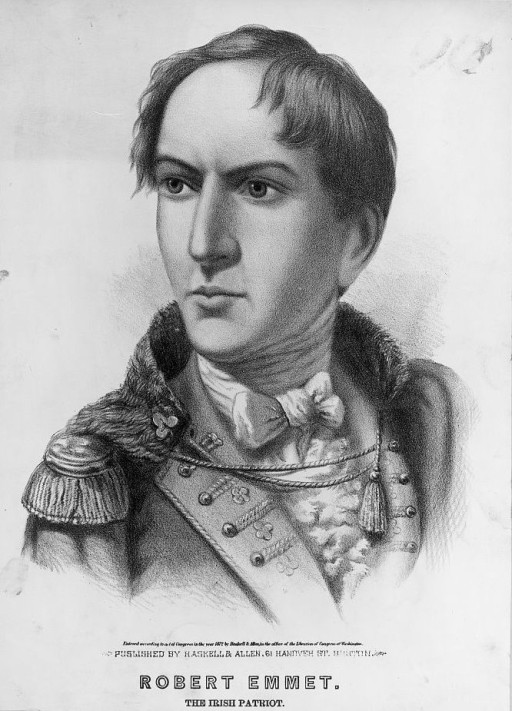Robert Emmet Remembrance Day
Half Way to St. Patrick's Day

By Valerie McGrew, Board Member, United Irish Societies of San Francisco
In 1916, one third of the population of San Francisco was Irish or of Irish descent and largely supporters of the struggle for Irish independence. When news of the Easter Rising reached them, they showed their support with guns, money and political advocacy—not only then but in the years to come. US Senator James Duval Phelan, the son of an Irish immigrant and former mayor of San Francisco, was one such supporter who used his political influence in promote the cause including reading remarks into the minutes of the US Senate. Senator Phelan commissioned a copy of the bronze statue of Robert Emmet from artist, Jerome Connor. One of four statues, the others stand in Washington DC, in Emmetsburg, Ohio, and in St Stephen’s Green, Dublin. The Washington DC statue, the first one cast, was dedicated in 1917. The San Francisco statue was erected in the Golden Gate Park in the band concourse beside the Academy of Science in 1919. When the Academy was remodeled, it was moved to a more prominent spot in front of the building.
On July 20, 1919, the statue was unveiled by Eamon De Valera, future Taoiseach and President of the Republic of Ireland. De Valera, who had been one of the leaders of the Easter Rising and had recently escaped from British custody, was on a fundraising tour of the United States, which netted millions of dollars. One of his stops was San Francisco, where his friend and editor of The Leader newspaper, Father Peter Yorke, helped him rally supporters to donate money to the struggle.
Robert Emmet, leader of the Rebellion of 1803, was an inspiration to the leaders of the 1916 Rising. In 1916, there were still people living in Ireland who would have heard stories of Wolfe Tone’s Rebellion of 1798 and Emmet’s Rebellion of 1803 from their grandparents much like older San Francisco natives of today heard stories of the great Earthquake of 1906 from their grandparents.
The Society of United Irishmen were a non-sectarian organization made up of Presbyterians, Catholics and members of the Church of Ireland, which advocated for parliamentary reform and emancipation for Irish Catholics and Presbyterians. Inspired by the American Revolution and the French Revolution, they evolved into a revolutionary organization which sought to end British rule and to establish an independent Ireland. United Irishmen like Theobald Wolfe Tone, leader of the 1798 Rebellion, and Emmet brothers, Thomas Addis and Robert, were members of the Protestant Ascendency and of the Church of Ireland yet they put their very lives at risk to support the emancipation of Irish Catholics. Tone and Robert Emmet did indeed lose their lives and Thomas Emmet went into exile. Their defeat was the last time the Protestants and Catholics would stand together in great numbers in the struggle for independence.
After the failure of the 1798 Rebellion and Wolfe Tone’s death, his close friend, Thomas Addis Emmet, went into to exile in the United States; and Robert Emmet began to re-organize the United Irishmen with the goal of preparing a new rebellion.
In 1803, Emmet was forced to start the rebellion prematurely when one of his arms’ depots exploded. He failed to receive reinforcements from other rebel groups in Wicklow and Kildare but nonetheless on July 23, 1803, his forces in Dublin went into action. He soon loss control of the situation and the rebellion was easily crushed by the British.
Emmet went into hiding and fled to Harold’s Cross to be near his fiancé, Sarah Curran. Sarah was the daughter of John Philpot Curran from Newmarket, Cork. Sarah and Emmet had met through her brother, who was his fellow student at Trinity College. Her father strongly disapproved of the courtship and disowned her when they became engaged. Her father never relented and even denied her request to be buried at Rathfarnham—next to her sister, Gertrude—when she died tragically of TB in 1808 after her marriage to Captain Sturgeon and the death of her one-month old son. She was buried in Newmarket, Cork.
The story goes that Emmet probably would have been able to escape to France if he had not taken the opportunity to say adieu to Sarah. Regardless, he was captured on August 23, 1803 and put on trial. At his trial on September 19, he was found guilty of high treason and sentenced to death. Prior to his sentencing, he delivered his famous Speech from the Dock, which has been an inspiration to generations of proponents of a United Ireland to this very day.
Let no man write my epitaph: for as no man who knows my motives dare now vindicate them. Let not prejudice or ignorance asperse them. Let them and me repose in obscurity and peace, and my tomb remain uninscribed, until other times, and other men, can do justice to my character; when my country takes her place among the nations of the earth, then, and not till then, let my epitaph be written.
I have done.
Learn more about the Robert Emmet Monument in Golden Gate Park